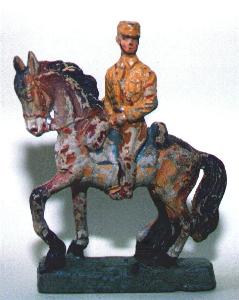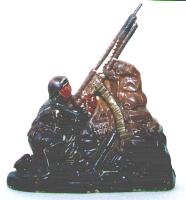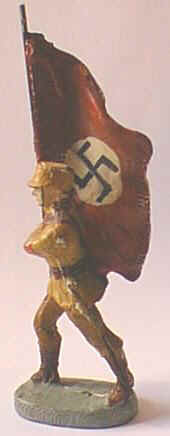
These figures are made of various materials, most commonly a mixture of sawdust and glue moulded around a metal armature, they were produced roughly from around the turn of the 20th Century until the end of WW2. Some production continued after the war but in due course this material was superceded by advances in plastic technology. They are generally associated with the German toy market, where they are known as "Masse Figuren", through the products of the market leaders ELASTOLIN and LINEOL. The products of these two outstanding manufacturers have already received a lot of good coverage, so I'm not going to repeat what other people have already written so much better than I could. However, Composition Figures were also very very popular in France, as well as Belgium and Italy, where they were produced into the 1950s. In Italy they are known as "Pasta Figures"

This is an SA man (Sturm Abteilung - storm trooper) made in Germany during the 1930s by LEYLA, one of the smaller manufacturers. The swastika on his red armband has been scratched off, which is common on such figures of this period as it was illegal to show this symbol in Germany for several decades after the war. This is a one piece casting and the style is reminiscent of earlier ornamental ceramic figures. The smaller manufacturers are not widely collected, and the sculpting is generally poorer, the paint on this one is quite worn so it's not worth much but it has a nice toy quality about it which I really like.
It took a lot of searching to identify the uniform of this kneeling figure, his tunic is unremarkable but the hat is very distinctive, eventually I tracked him down as a Russian Caucassus rifleman from about 1900. He is a 10cm scale figure and carries no manufacturers name but is marked "Foreign", my guess is that he may be made by ELASTOLIN before 1920.
This SA man marching with slung rifle from the mid 1930's is quite rare but has been badly damaged, the rifle has been completely repaired and as a result it is virtually valueless.
The first two figures are 54mm French made but maker unknown. The Battle of Britain pilot in well detailed flying suit was one of the first ever figures from TIMPO (probably made by ZANG for TIMPO before the latter started manufacturing), it was also made in 20mm size and sold in boxed sets with metal aircraft. The pilot in white is a 60mm plastic figure which has sneaked onto this page, he's part of a naval set originally hollowcast made in France by HR (Henri Roger) and later sold under the MIGNAJOUETS name in plastic
Composition figures were made in various sizes, the first two here are 54mm by ELASTOLIN. The smaller two are by LINEOL the officer saluting is 40mm while the grenadier (painted in Danish uniform) is 30mm high
More smaller scale composition figures, the first a zoo keeper by ELASTOLIN, next a Japanese naval officer (manufacture unknown) which came with tinplate battleships commemorating the Battle of the Tsushima Straits in 1904. The Sikh infantryman marching is by ELASTOLIN while the Prussian in pickelhaube and bass drummer are by LINEOL.
Another great favorite of mine, this cowboy and indian chief are locked in a desperate struggle and are beautifully sculpted. They have both lost their weapons, the cowboy was originally armed with a knife while the indian has a tomohawk. Made by ELASTOLIN.
This French standard bearer of the First World War is made by CELLOSE, it's about 75mm high and the flag is made of silk. So far I have found WW1 French infantry, Senegalise tirailleurs and Napoleonic figures by this manufacturer.

The French Anti-Aircraft gunner is made by DOMAGE and it's about 60mm high. This manufacturers figures are quite distinctive because they are made of some kind of plaster or flour mix and they are hollow inside!
 This Elastolin SA standard bearer was
produced in 1934 and is distinguishable as such because the
figure is wearing the full length tunic rather than just a brown
shirt. The reason for this is that Elastolin utilised the
existing figure of a German army standard bearer from the 1920's
and simply put a new head on it. The following year they produced
completely new designs of the SA in shirts. Elastolin commonly
put different heads on the bodies of standard German infantry
figures to portray the armies of other nations, this in turn lead
them to make personality figures from the Third Reich with
porcelain heads which much improved the detail of the faces.
This Elastolin SA standard bearer was
produced in 1934 and is distinguishable as such because the
figure is wearing the full length tunic rather than just a brown
shirt. The reason for this is that Elastolin utilised the
existing figure of a German army standard bearer from the 1920's
and simply put a new head on it. The following year they produced
completely new designs of the SA in shirts. Elastolin commonly
put different heads on the bodies of standard German infantry
figures to portray the armies of other nations, this in turn lead
them to make personality figures from the Third Reich with
porcelain heads which much improved the detail of the faces.
Porcelain head figures were a lot more expensive than the ordinary range and today they are much in demand by collectors. After the war the remaining stock of porcelain heads were used to stuff the bodies of the elephants in the zoo range in order to reduce the amount of material needed. These elephants are now dificult to find undamaged due to collectors cutting them open in search of porcelain heads!
These two very crude SA men are about 54mm tall and carry no maker's name
This is King Attilla "The Hun" as depicted by DURSO of Belgium
This
energetic model of Buffalo Bill was produced by Emil PFEIFFER
of Vienna around 1900-1910, this manufacturer was better known
for producing dolls and went on to make the earlier figures for
Elastolin. This is probably the largest figure in my collection,
measuring 14.5 cm from the tip of his hat to the base.
Composition figures are notoriously prone to damage or disintegration if stored in damp conditions, the wire armature inside them rusts and expands cracking the figures open. So condition is paramount when it comes to their value, sadly Buffalo Bill has lost his right arm and the paint is flaking badly which means that this nice early toy has only a nominal value. (It's still one of my favorites though).
Reichsmarshal Goering as depicted by ELASTOLIN, this is one of the porcelein head figures mentioned above. Again he is in such poor condition that he is only worth keeping for that head!
These
two figures aren't strictly composition but they are similar in
style and size so I've included them here, they're actually made
of rubber by Czechoslovakian firm BATA who are better known (in
the UK at least) for making shoes! The range included a very
attractive mounted officer which I'm still searching for. The
only other Czechoslovakian figures that I've come across are
pirated copies of AIRFIX in plastic and crude composition copies
of ELASTOLIN made by a company called DUROLIN.
ELASTOLIN continued in production after WW2, these figures are made in a lighter more resin like material than the pre-war "sawdust and glue", the new heads are made of plastic while the bodies are the 65mm infantry from the late 1920's. These figures were produced in a number of paint finishes to represent the post-war American and Continental European armies
More post-war production, the first by LINEOL was a new design of the East German army in a tough rubber material, made in the DDR. The bandsman of the Bundeswher is by LEYLA and his Lyre is made of plastic. Finally there is a plastic copy of an ELASTOLIN infantryman goosestepping which was made of plastic in Mexico by GULIVER his right arm was moulded separately and heat soldered to the body.
Return to:Home Page